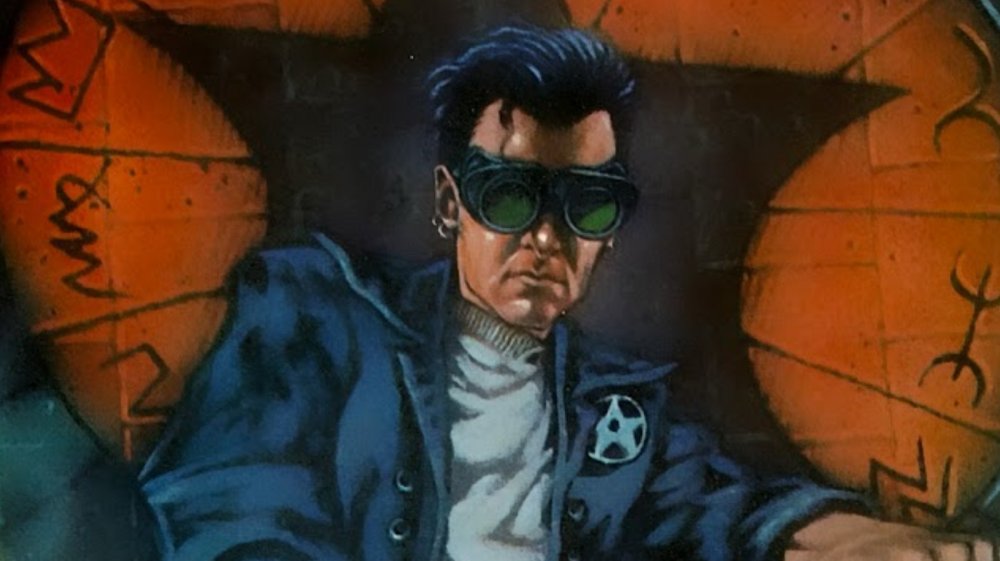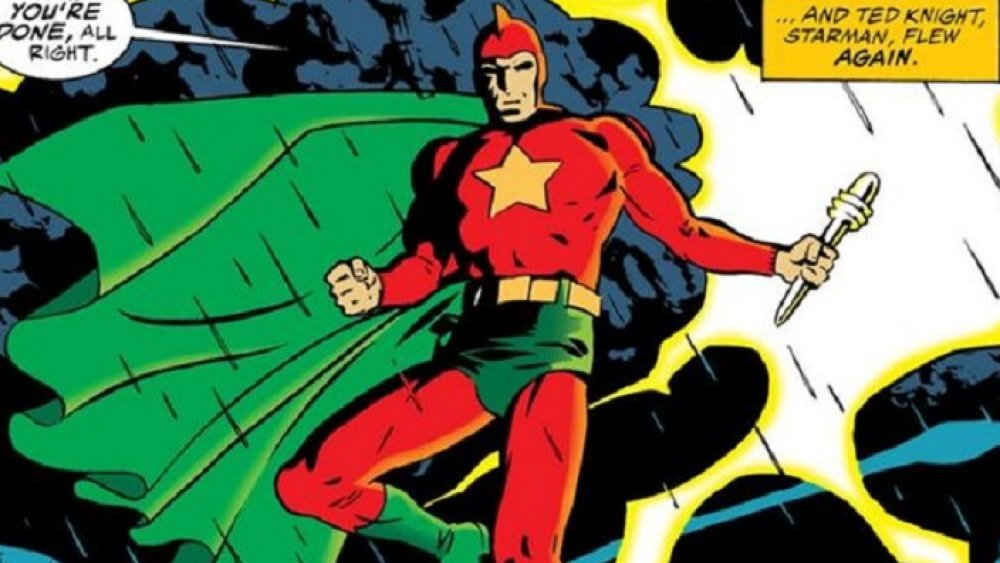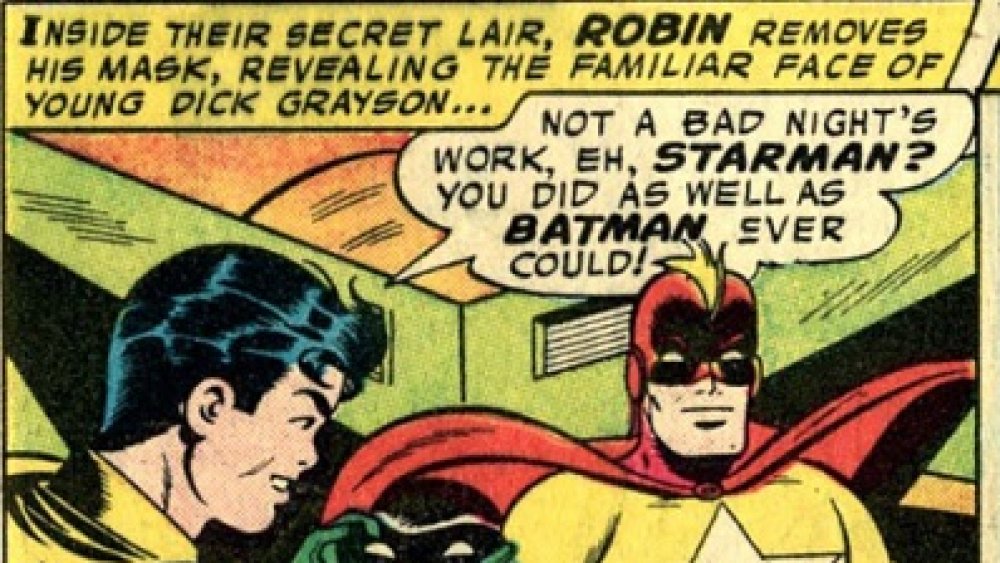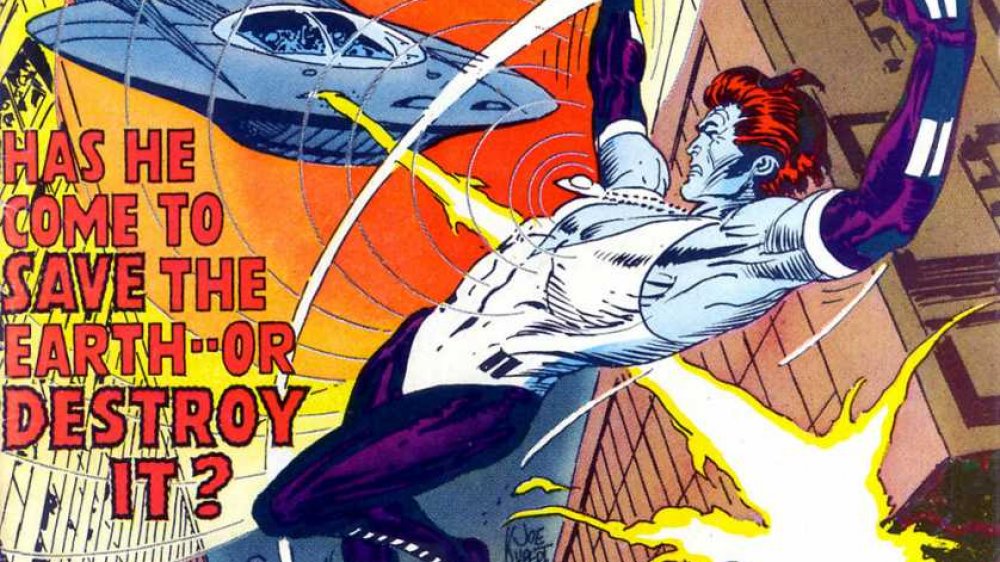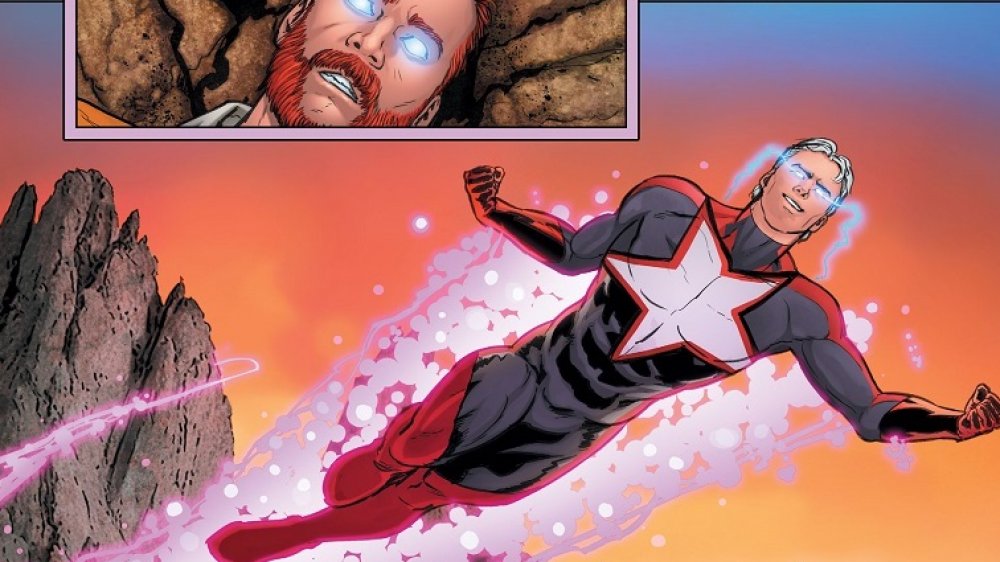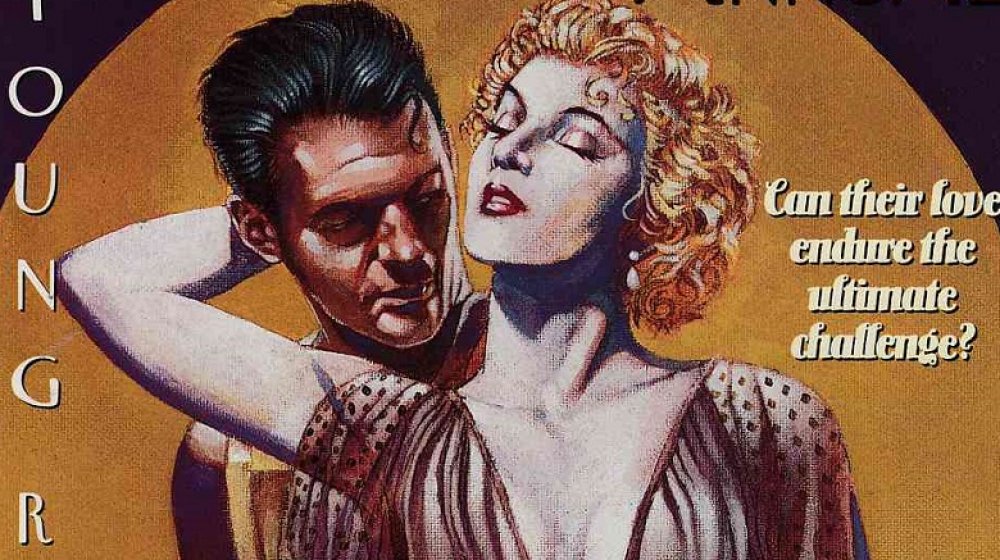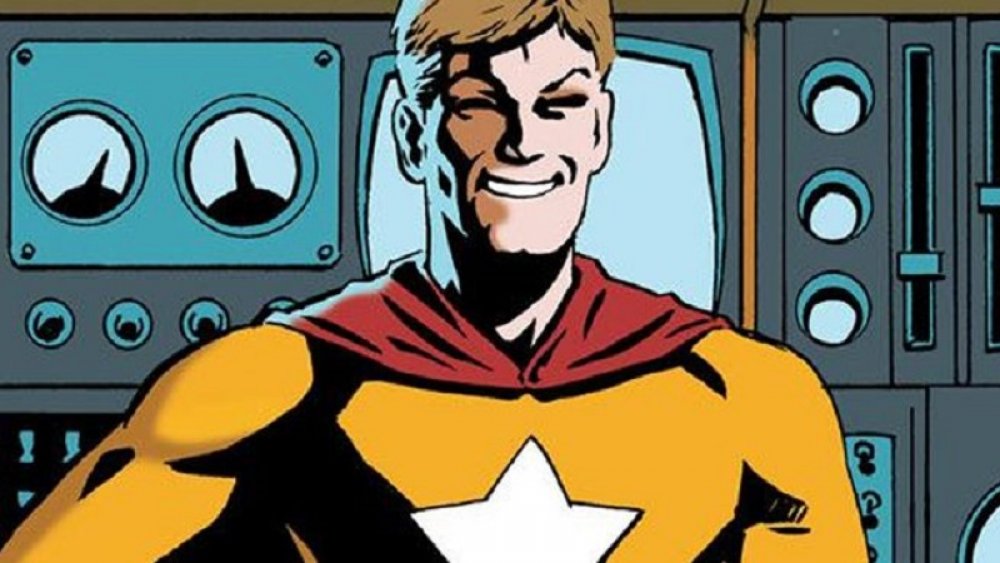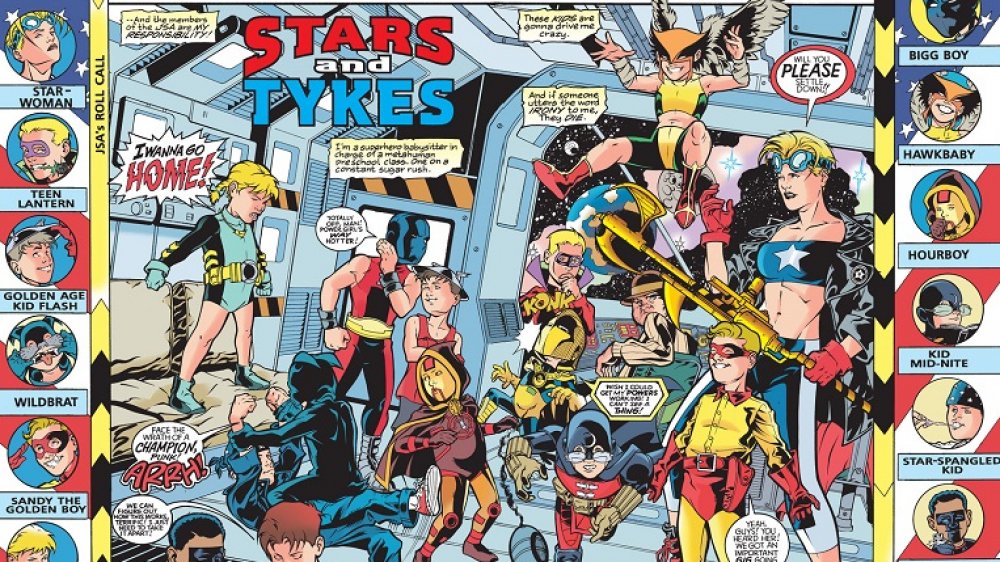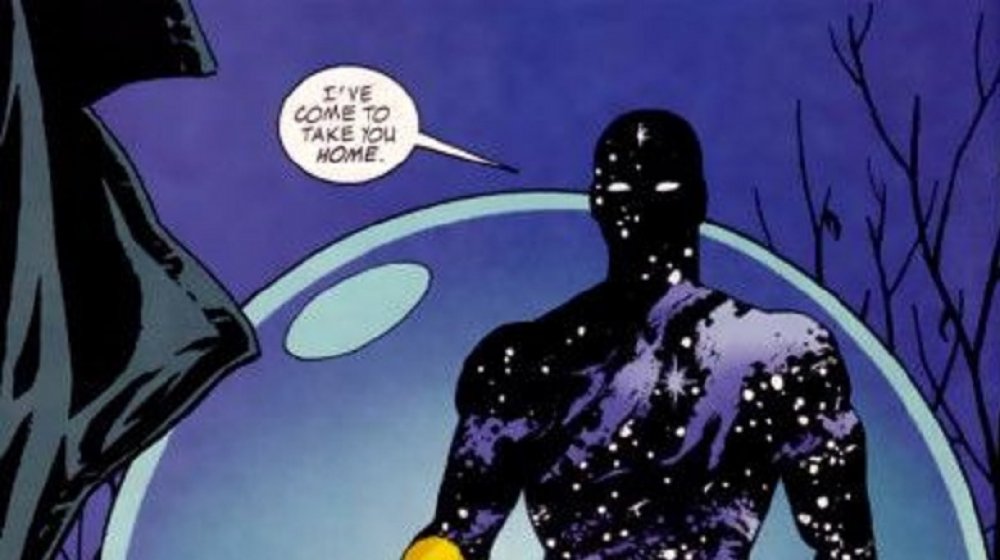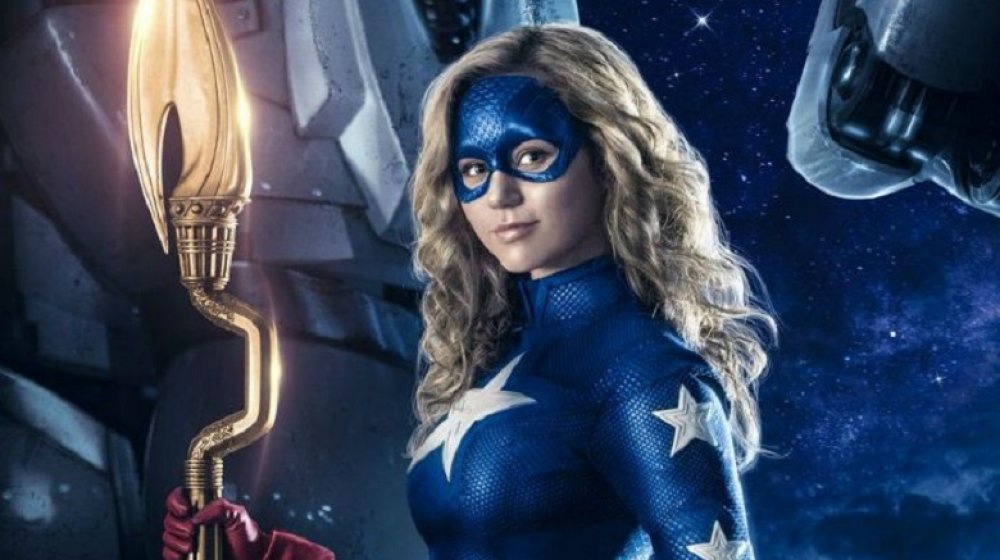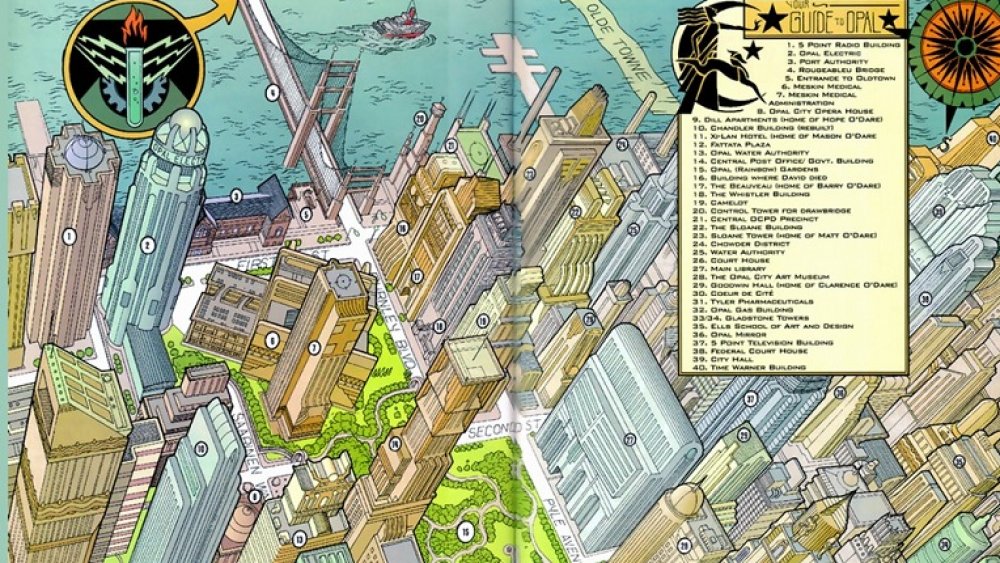The Untold Truth Of DC's Starman
Starman has been part of the DC universe since his debut in 1941. Unlike many DC heroes who have had just one or two incarnations, however, 11 different men have shouldered the Starman mantle at one point or another. And that doesn't even include Stargirl, a character who acts as a reinvention of and successor to the Starman legacy.
Where does one begin with Starman? Well, you have a few options. There's Ted Knight, the original Starman, and his son Jack Knight, likely the two most well-known Starmen. Ted was created by writer Gardner Fox and artist Jack Burnley, while Jack Knight was created by James Robinson and Tony Harris in a 1994 revival of the title. During the latter comic's Eisner Award-winning run, Jack and Ted are connected to the many other Starmen out there — and to some heroes who simply have the word "star" in their name. There are alien Starmen inspired by David Bowie, time-traveling Starmen, Starmen who stand to inherit extraterrestrial thrones, and even a dead Starman, who can nevertheless talk to the living.
Sound confusing? It is — but it's all held together by the Starman mantle's legacy of family, generational inheritance, and heroism. We're here to break down the Starman story, from the 1940s' tales of super science to the 1990s' reinvention of the character and his history.
The many sides of Ted Knight
Unlike many rich superhero playboys, Ted Knight, the very first Starman circa 1941, actually enjoys the parties and the social hobnobbing that fill his days. At the same time, he's obsessed with astronomy, physics, and engineering, and his interests lead him to invent what is first called the Gravity Rod, and later, the Cosmic Rod. He is convinced by his cousin Sandra, aka the Phantom Lady, to fight crime as the spectacular Starman.
Ted becomes a member of the Justice Society and the All-Star Squadron during World War II, and even becomes one of the scientists who helps develop the atomic bomb. The crushing guilt he feels after the bomb is used, along with the traumatic murder of his girlfriend Doris, leads to a mental breakdown. It takes the intervention of his time-traveling son Jack and the resolution of Doris' murder to bring him back into the world in the '90s Starman series. Ultimately, towards the end of that comic's run, he sacrifices his life to save Opal City.
Ted is a complex figure with a variety of flaws — but he is nevertheless a staunch hero in the DC tradition. Sure, he stumbles from time to time, but in the end, he's a sterling father, scientist, and a superhero.
Twinkle, twinkle, little bat
One of the most enigmatic figures of the '90s Starman series is the Starman of 1951, who took on the role for just one year. This Starman is, in fact, a retconned version of Batman, glimpsed in 1957's Detective Comics #247. In this issue, an evil scientist manages to give Batman a phobia of bats — so Bruce Wayne replaces his signature bats with stars. Instead of a Bat-Signal, he has a Star-Signal. Instead of Batarangs, he uses Star-Darts. In the end, Robin uses exposure therapy to cure Bruce, who goes back to being a creature of the night.
The '90s Starman series makes Charles McNider, the first Doctor Mid-Nite, into Starman instead of Batman. At the time, Ted Knight is incapacitated and is in and out of sanitariums after his nervous breakdown. McNider sees the need for Opal City to have a champion, and he takes over until a replacement is found. This replacement turns out to be a time-traveling David Knight, son of Ted Knight and older brother to Jack Knight. He takes over for his dad, but David lasts less than a week before he is murdered by Kyle, the son of Ted's arch-enemy, the Mist. He is eventually given a second chance to be Starman, this time in the past. David makes the most of it and is even able to team up with Jack before he has to meet his fate in his own era.
Let all the children boogie
Blue-skinned alien Mikaal Tomas was created by Gerry Conway and Mike Vosburg in 1976. This Starman wasn't inspired by Ted Knight, but by the David Bowie song of the same name. Mikaal Tomas is an alien sent to destroy the Earth, but luckily for us, he decides to defend Earth's people instead. This 1976 issue was his first and only appearance until the '90s series revived him.
The '90s Starman series explains his absence after that first appearance by leaning into another Bowie vehicle: The Man Who Fell To Earth. In that film, Bowie plays an alien on a mission to save his planet who becomes ensnared in hedonism. Mikaal Tomas falls into a similar lifestyle, becoming part of a romantic triad, partying at discos, guzzling alcohol, and snorting drugs. He eventually becomes so out of it that he's kidnapped by an energy leech named Bliss, who keeps him as a captive at a freak show for years. Jack Knight rescues him, and Mikaal slowly recovers, eventually regaining his fighting edge when he goes into outer space to help Jack find yet another Starman, Will Payton. David Knight even pops up to talk to him a couple of times from beyond the grave, letting him know that one day he'll have to take over for Jack.
Mikaal is unique among Starmen in another way as well: His relationship with his boyfriend Tony is a rare instance of a healthy gay relationship in '90s mainstream comics.
Two Starmen, one body
Introduced in 1980's Adventure Comics #467, Prince Gavyn of Throneworld has nothing to do with any of the Starmen of Earth ... or so he thinks. As a bored, spoiled playboy, he's a classic comics archetype — he has no interest in ruling Throneworld and is happy to let his sister do it. The only problem is that it is customary to throw potential threats to the throne out of an airlock in case they decide to get ambitious. Thus, Gavyn is tossed into space. But he doesn't die, thanks to his hitherto unknown cosmic powers. Wielding a staff not unlike Jack Knight's Cosmic Rod, he dons a mask and becomes the protector of Throneworld's downtrodden. When his sister is murdered, he ascends the throne and is beloved by all.
He apparently dies during Crisis On Infinite Earths ... except he doesn't. A new Starman series debuted in 1988, featuring an Earth man named Will Payton in the title role. He has the usual array of powers: flight, strength, and energy beams. He's disintegrated fighting Eclipso ... except he isn't. Turns out, Gavyn is the one who zapped Will with powers in the first place. He turned into pure energy upon his first "death," beaming across the universe until he found Will. His essence is thus merged with Payton's, and that energy beams back to Throneworld after Eclipso's attack. Eventually, Jack frees him, and Gavyn retains both his and Will's memories. He decides to stay on Throneworld.
Jack Knight walks away
From the beginning, Jack Knight, star of the '90s Starman series, isn't like other heroes. He rebels against his famously heroic dad Ted, first as a punk rocker and then as someone obsessed with collectibles — he's a professional memorabilia dealer with a shop called Knight's Past. When he's forced to become Starman, Jack does it on his own terms: He refuses to wear a costume, usually going into battle wearing a leather jacket with a toy sheriff's star on it. Over the course of the series, Jack and Ted come to understand and appreciate each other, despite the many differences between them.
One horrific night, the Mist's daughter, Nash rapes an unconscious Jack and conceives a child. She plans to raise him to hate Jack, but her own father kills her. Being responsible for his son makes Jack want to quit the hero business, and hearing that his ex-girlfriend Sadie is pregnant with his child seals the decision. He makes sure Opal City has defenders, gives the Cosmic Rod to Courtney Whitmore, AKA Stargirl, and drives away from the hero life.
Talking with David
Once a year, the '90s Starman series featured a "Talking With David" issue, in which Jack talks with his deceased brother David. Because of a pirate's curse on Opal City, David's spirit didn't move on when he died, and thanks to a favor from Dr. Fate, David is able to interact with Jack. These meetings heal a lifetime's worth of enmity.
The first such story came in Starman #5, when Jack Knight suddenly appears in black and white and sees his dead brother David dressed in the red and gold Starman suit. They meet in a cemetery and begin working out their mutual contempt and bitterness. David, ever his father's son, rarely sees eye-to-eye with Jack. Their second meeting puts them on a big pirate ship adventure. Their third time together happens at a dinner party with a large group of dead Golden Age heroes, who all have advice for Jack. David also visits Mikaal Tomas twice after that, offering him advice and encouragement.
David's last visit with Jack comes after Ted dies saving Opal City, meaning Jack gets to visit with both of them. They send Jack back to 1951, where he teams up with fellow time-traveler David, and encourages Ted to take up the Starman mantle once again.
Jack And Courtney
Jack Knight and Courtney Whitmore do not get off to a good start. When they join a newly-reformed Justice Society with Courtney still in her Star-Spangled Kid identity, Jack finds her to be stubborn, bratty, and an all-around annoyance. Courtney, in turn, is tired of him being on her case all the time. The truth is that they're too much alike to get along. Jack, being an adult, should understand this, but he's still a big kid himself.
During a 2000 adventure where Klarion the Witch Boy age-swaps young and old heroes, the JSA is turned into toddlers while Courtney is aged into adulthood. The team flies off into space on a quest to find a de-aging gun, and Courtney has to play babysitter to a bunch of rambunctious super-tots. Little Jack gives her the Cosmic Rod to use, and while he proves to be a handful, he also gives her advice on how to use it.
When it comes time to name his successor, Jack says that when he saw her as an adult Starwoman, he knew she'd be the right choice. In Starman #80, the series finale, Jack comes totally clean: "I wasn't nice. I wasn't a hero. I was bad news. You ... you're 24 carats, baby. As bright as the sun." He hates that she's a better version of him, but he grows to understand it's why she'll do so well in carrying on the Starman legacy.
Farris Knight gains a conscience
During the DC One Million event, the Starman of the 853rd century, Farris Knight, plays a prominent role. The Justice Legion of the future comes back to the 20th century in order to retrieve the current-day JLA, so they can celebrate the return of the Prime Superman. However, there is a traitor on the team: Farris Knight. He's a direct descendant of Ted Knight, but also a direct descendant of Starman's nemesis, the Mist. His mission in the 20th century is to kill Ted Knight and plant Kryptonite on Mars for Solaris, a corrupted sun and Superman villain, in the future.
Farris reveals that after 3000 years without a Starman, his great-grandfather found a device called a Quarvat and used it to fight evil. His son, Cale Knight, took the Quarvat when the time came and became one of the greatest Starmen ever. His mother also took up the mantle, and explored Knight family history. Farris, in contrast, has never wanted to be a hero. He travels back in time to kill Ted — but Ted accepts him with kindness, and simply asks Farris to look inside himself and see if there is good there, too. Farris ends up sacrificing his life to save Earth from Solaris, with his great-grandfather finding the Quarvat millennia later.
Star Boy takes his turn
During an adventure in space, Jack Knight is warped into the future and meets Thom Kallor, AKA Star Boy of the Legion of Super-Heroes. Instead of using cosmic energy, he has the power to increase an object's mass. Thom is familiar with Jack and considers himself to be a part of the Starman legacy, name-checking other historical figures of Jack's era like Danny Blaine and Pat Dugan.
They go up against a ravenous darkness that has engulfed a planet, fighting for days until they find a future version of the Shade, Jack's friend from Opal City. The Shade has been poisoned by an enemy, and it manifests in his powers growing out of control — luckily, they are able to cure the Shade and save the day. The Shade reveals that Danny Blaine told him when and where to bring Jack forward into the future, to effect a cure and set up a fated meeting between Starman and Star Boy. How did Blaine know this? Because Thom Kallor traveled to the 21st century, changed his name to Danny Blaine, and became the new Starman. Of course, Thom knows exactly how Blaine is to die, but he accepts it like a hero. Decades later, and moments before his final fight, Blaine brings Jack back from 1951, and embraces his fate.
Generations
The Starman legacy is all about generational inheritance. Ted Knight looms large in the life of his sons as a hero. The Mist warps his children with hatred, to use them as instruments against Ted Knight. Jack Knight quits being Starman so he can raise his own children in a safe environment. Every person who holds the title across time and space feels a kinship to each other, and not just because many of them wield the same kind of cosmic energy.
This legacy continues with Stargirl, now making waves in her own CW TV show. Courtney Whitmore debuted in the pages of Stars and S.T.R.I.P.E., where she discovers that her stepfather Pat Dugan was once Stripesy, the sidekick of Sylvester Pemberton, the Star-Spangled Kid. Pemberton wore a Cosmic Converter Belt, which enhanced his strength and speed. Whitmore uses the belt to become a superhero in her own right.
On the TV show, Dugan was still Pemberton's sidekick, but here he was Starman, wielding the Cosmic Staff. Courtney takes up his mantle in part because she believes Starman was her real father and wants to capture his killers, the Injustice Society. These legacies form the crux of the first season, along with the father-daughter dynamic of Pat and Courtney. What parents give to and demand of their children, and how those children react, is a powerful storytelling device, and the foundation of the Starman story.
Opal City
Opal City, introduced in the '90s Starman series, is as much a character as the men who take on the mantle of Starman. The character who brings the city most vividly to life is the immortal Shade: Even during his time as a villain, the Shade never commits any crimes in his beloved home. He's there in Opal's earliest days, he watches the city's expansion into the 20th century, and he sees its beautiful Art Deco spires built.
This careful building of Opal City's history and present pays off in the '90s Starman series' "Grand Guignol" storyline. The Shade's long-time nemesis, Simon Culp, engineers a grand scheme with an army of villains to destroy Opal City, because he knows it's what the Shade loves most. The story is compelling because readers are just as invested in Opal as they are in Jack Knight, the technical hero of the story, and thus, a plot like this raises the stakes massively. Opal City might not be as famous as Gotham or Metropolis, but it's every bit as special. We recommend spending some time there yourself.
